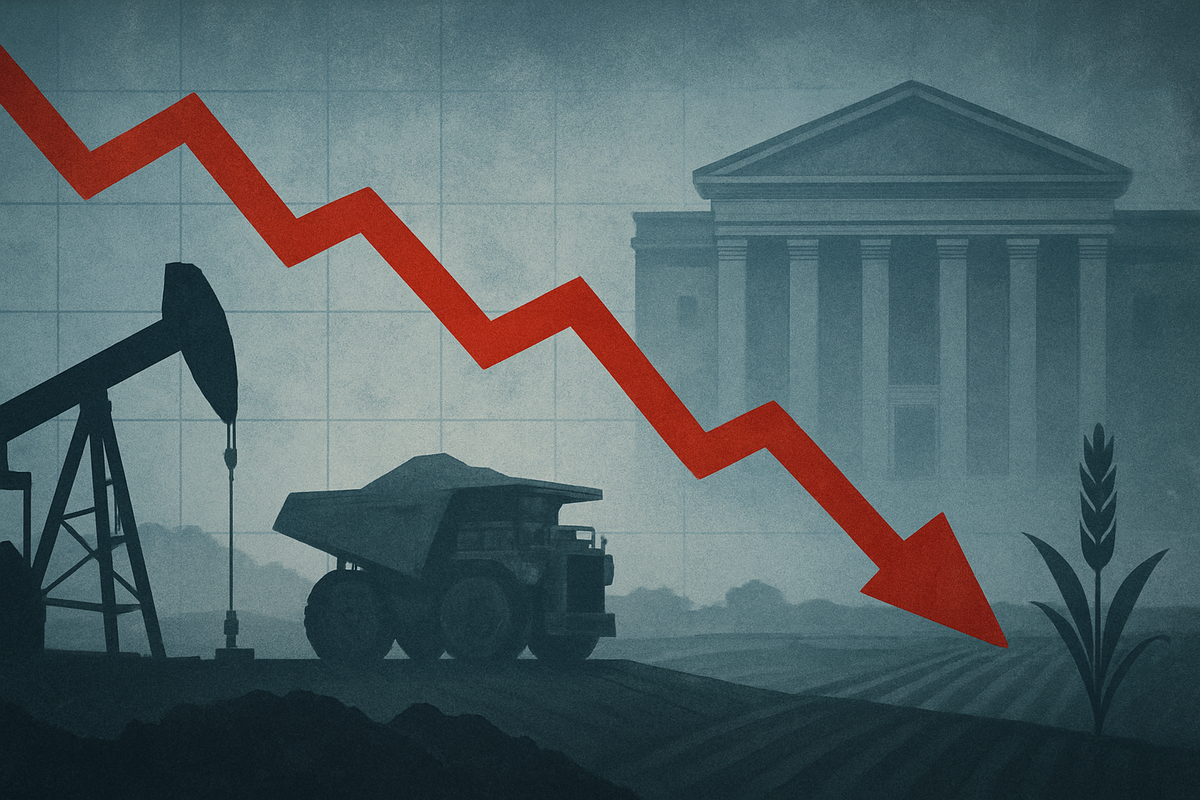
Toronto, ON – November 14, 2025 – Global financial markets are currently navigating a turbulent period, grappling with the twin forces of declining commodity prices in several key sectors and a decidedly hawkish stance from the U.S. Federal Reserve. This confluence of factors has significantly dampened investor sentiment, leading to widespread market corrections and particularly impacting resource-heavy exchanges like the Toronto Stock Exchange (TSX). Hopes for imminent interest rate cuts, once a beacon for market optimism, have rapidly faded, replaced by the stark reality of a "higher for longer" interest rate environment.
The immediate implications are clear: increased market volatility, a "risk-off" sentiment dominating trading floors, and a re-evaluation of asset valuations across the board. While some commodities, such as crude oil and natural gas, have seen recent upticks due to geopolitical tensions and weather forecasts, precious metals and industrial metals are experiencing significant downward pressure. This divergence, coupled with the Fed's firm hand, has sent ripples through global equities and bond markets, forcing investors to recalibrate their expectations for economic growth and monetary policy.
The Unfolding Market Correction: A Detailed Account
The current market downturn is the culmination of a series of events and policy shifts that began in late 2024 and intensified throughout 2025. The narrative has been shaped by a cautious Federal Reserve, fluctuating commodity markets, and significant geopolitical and trade policy developments.
Timeline of Key Events:
- Late 2024: The Federal Reserve initiated a hawkish tilt, revising down its projected interest rate cuts for 2025 from four to two, signaling a less accommodative stance than initially expected.
- Early 2025: By February, the stock market began to decline. In March, OPEC+ announced a plan to gradually increase crude oil output starting in April, while the Fed held rates steady and raised core inflation projections, partly due to anticipated U.S. tariffs.
- April 2, 2025 – "Liberation Day" Tariff Crash: U.S. President Donald Trump introduced sweeping new tariff policies, triggering widespread panic selling across global stock markets. The Nasdaq Composite plummeted by 1,600 points, the S&P 500 lost 4.84%, and the Dow Jones fell by 1,679 points. China's retaliatory tariffs on April 4 further exacerbated the downturn, pushing the Nasdaq into bear market territory.
- Mid-2025: Brief Recovery: A temporary pause in tariff increases and a trade deal between the U.S. and China led to a stock market rally, with the S&P 500 reaching all-time highs by June. Signals from the Fed about a potential easing cycle in August further boosted optimism.
- September-October 2025: Rate Cuts and Hawkish Shift: The Fed proceeded with interest rate cuts in September and October, bringing the federal funds rate to 3.75%-4.00%. However, Federal Reserve Chair Jerome Powell's press conference after the October FOMC meeting was unexpectedly hawkish, signaling that a December rate cut was "not a foregone conclusion." He cited the Fed was "flying blind" due to a prolonged 43-day U.S. government shutdown that disrupted economic data. OPEC+ also projected a "balanced demand and supply," contributing to lower oil prices.
- November 2025: Fading Hopes and Renewed Plunge: Leading up to November 14, 2025, a chorus of hawkish remarks from various Fed officials further diminished hopes for a December rate cut. On November 13, traders' bets on a December rate cut fell to around 50%. This triggered a broad market downturn, with Wall Street stocks dropping sharply, U.S. Treasury rates rising, and oil prices falling below $60 a barrel. Gold and silver prices plummeted as non-yielding assets became less attractive. On November 14, the Dow Jones Industrial Average plummeted another 500 points, extending a week of losses, with the S&P 500 and Nasdaq Composite also continuing their decline.
Key Players Involved:
The Federal Reserve has been at the epicenter of this shift, with Chair Jerome Powell setting a hawkish tone. Other influential Fed officials include Beth Hammack (President, Cleveland Federal Reserve Bank), Alberto Musalem (President, St. Louis Federal Reserve Bank), Neel Kashkari (President, Minneapolis Federal Reserve), and Mary Daly (President, San Francisco Federal Reserve), all of whom have emphasized caution regarding rate cuts and the need to combat persistent inflation. On the commodity front, OPEC+, led by Saudi Arabia and Russia, has played a significant role by gradually increasing oil output, contributing to an anticipated supply surplus. U.S. President Donald Trump's tariff policies in April 2025 were a direct trigger for a major market crash and continue to influence global trade dynamics.
Initial Market Reactions:
The market reactions have been swift and broad-based. Equities have seen widespread sell-offs, particularly in the technology sector, with major tech and AI-linked stocks like Palantir (NYSE: PLTR), Nvidia (NASDAQ: NVDA), Micron (NASDAQ: MU), and Western Digital (NASDAQ: WDC) leading the decline. Financials initially struggled as the prospect of fewer rate cuts limited net interest income expansion but may find some benefit from higher-for-longer rates. Bonds and Treasuries experienced a flight to safety initially, but then widespread selling pushed yields higher as rate cut hopes faded. Commodities have been divergent: oil became a "main loser" through much of 2025, though recent geopolitical events have provided some support; natural gas has been an outperformer; and precious metals like gold and silver plummeted on November 13-14, with gold falling to as low as $4,034.54 per ounce.
Winners and Losers on the TSX: A Sectoral Deep Dive
Toronto's TSX, with its substantial weighting in resource sectors, is particularly sensitive to these shifts. The combination of a hawkish Fed, fading rate cut hopes, and mixed commodity prices is creating clear winners and losers among public companies.
Energy Sector:
- Potential Losers: Companies heavily reliant on oil and gas extraction, such as Suncor Energy Inc. (TSX: SU), Canadian Natural Resources Limited (TSX: CNQ), Cenovus Energy Inc. (TSX: CVE), Imperial Oil Limited (TSX: IMO), Tourmaline Oil Corp. (TSX: TOU), MEG Energy (TSX: MEG), Baytex Energy (TSX: BTE), and Peyto Exploration & Development Corp. (TSX: PEY), are vulnerable to sustained lower crude prices. Reduced revenue per barrel directly squeezes profit margins, impacting capital expenditures and dividend sustainability.
- Potential Winners: Midstream companies like TC Energy Corporation (TSX: TRP) and Pembina Pipeline Corporation (TSX: PPL), which operate pipelines and storage facilities, tend to be more resilient. Their revenue is based on volumes transported, offering more stable cash flows less directly exposed to commodity price fluctuations. Integrated energy companies like Suncor Energy Inc. (TSX: SU) and Imperial Oil Limited (TSX: IMO), with significant refining operations, could conditionally benefit from lower input costs for their downstream businesses, offsetting some upstream losses.
Mining Sector:
- Potential Losers: Precious metal miners such as Agnico Eagle Mines Limited (TSX: AEM), Barrick Gold Corporation (TSX: ABX), Kinross Gold Corporation (TSX: K), Wheaton Precious Metals Corp. (TSX: WPM), and Franco-Nevada Corporation (TSX: FNV) are directly impacted by the recent sharp decline in gold and silver prices. High-cost producers are particularly vulnerable. Base metal miners like First Quantum Minerals Ltd. (TSX: FM), Ivanhoe Mines Ltd. (TSX: IVN), Lundin Mining Corporation (TSX: LUN), and Capstone Copper Corp. (TSX: CS) also face headwinds from a global economic slowdown, which dampens demand and prices for industrial metals.
- Potential Winners: Low-cost precious metal producers like Silvercorp Metals Inc. (TSX: SVM) are better positioned to maintain profitability even with compressed margins. Miners of strategic transition metals such as Teck Resources Limited (TSX: TECK), particularly those focusing on copper, might see more resilient demand in the long term due to their role in the energy transition.
Financials Sector:
- Potential Losers: Major Canadian banks, including Royal Bank of Canada (TSX: RY), The Toronto-Dominion Bank (TSX: TD), Bank of Montreal (TSX: BMO), Canadian Imperial Bank of Commerce (TSX: CM), Bank of Nova Scotia (TSX: BNS), and National Bank of Canada (TSX: NA), face headwinds from a "higher for longer" interest rate environment. This can increase funding costs, dampen loan growth, and elevate the risk of loan defaults, particularly in sectors like real estate, necessitating higher provisions for credit losses.
- Potential Winners: Insurance companies like Manulife Financial Corporation (TSX: MFC) and Sun Life Financial Inc. (TSX: SLF) could conditionally benefit from higher investment income on their fixed-income portfolios over time, assuming effective asset-liability matching. Companies across all sectors with strong balance sheets and low debt are also better positioned, as they face less pressure from increased borrowing costs.
Wider Significance: A Global Reassessment
These market shifts are not isolated events but rather integral parts of broader industry trends and carry significant ripple effects across the global economy.
Broader Industry Trends: The global economy is transitioning from a period of acute supply-side shocks to a slowdown driven more by demand-side factors. Inflation, particularly in the U.S., has proven "stickier" than expected, hovering around 3%, well above the Fed's 2% target. This necessitates a "monetary policy normalization" rather than rapid easing, leading to subdued global growth. The increased market volatility and divergence in commodity performance, coupled with the lingering impact of U.S. tariffs, underscore a highly uncertain environment. There are also growing concerns about the sustainability of the AI-driven market rally, contributing to recent equity weakness.
Potential Ripple Effects:
- Increased Borrowing Costs and Consolidation: Higher interest rates disproportionately impact smaller, less established companies, potentially leading to market consolidation as stronger players acquire weaker ones.
- Sector-Specific Vulnerabilities: Construction, real estate, and high-growth technology firms face dampened demand and higher financing costs. The mining sector will likely see reduced exploration and expansion.
- Global Currency Dynamics: A stronger U.S. dollar, driven by higher Fed rates, makes U.S. exports more expensive and imports cheaper, impacting the competitiveness of American multinational corporations, while potentially benefiting foreign companies exporting to the U.S.
- Supply Chain Strain: Tight monetary conditions and economic slowdowns could exacerbate supply chain disruptions, further complicated by tariffs.
Regulatory or Policy Implications: Governments will face pressure to implement fiscal policies that complement monetary tightening without stifling growth. Trade policy escalation, particularly U.S. tariffs, risks retaliatory measures and higher domestic inflation. There could be increased scrutiny on commodity market speculation. Proposals like those in "Project 2025" advocating for weakened oversight of financial markets and restrictions on the Federal Reserve's "lender-of-last-resort" function could foster financial risk.
Historical Precedents: The current environment draws parallels to the "Taper Tantrum" of 2013, where a hawkish Fed and a strengthening dollar created headwinds for commodities. The early 1980s (Volcker Era) also saw aggressive monetary tightening coincide with corrections in precious metal prices. The 1990s monetary tightening phases similarly impacted precious metals. These historical examples underscore the sensitivity of markets to shifts in central bank policy and the inverse relationship between real interest rates and non-yielding assets. The 2020s have already proven to be the most volatile decade for commodity prices since the 1970s.
What Comes Next: Navigating the New Normal
The path ahead for markets and industries will be defined by continued adaptation to a landscape fundamentally altered by persistent inflation and a hawkish monetary policy.
Short-Term Possibilities: Expect continued equity market volatility, especially in high-growth sectors. Bond yields will likely remain elevated as the "higher for longer" narrative solidifies. Commodity markets will continue to diverge, with precious metals facing headwinds while energy prices remain sensitive to geopolitical events. Highly leveraged companies will face increased debt servicing costs, and consumer discretionary spending may slow.
Long-Term Possibilities: The "higher for longer" interest rate environment is expected to persist, leading to slower global growth. Businesses will need to prioritize financial discipline, tangible profitability, and realistic valuations over aggressive growth. Inflationary pressures from geopolitical tensions and supply chain disruptions may continue. Structural shifts in commodity demand, driven by the low-carbon transition, will see metals for renewable energy gain importance, while fossil fuel demand may sag.
Strategic Pivots and Adaptations:
- For Businesses: Prioritize cash flow management, optimize working capital, and enhance operational efficiency. Effective debt management, strategic pricing, and supply chain resilience will be crucial. Regular scenario planning and stress testing are essential.
- For Investors: Consider a shift towards value stocks and defensive sectors. Diversification, including non-U.S. opportunities, is advisable. While precious metals face short-term headwinds, long-term contrarian investors might find entry points. Hedging strategies against currency and commodity price volatility are important.
Market Opportunities and Challenges:
- Opportunities: Value investing in fundamentally strong companies, potential improved profitability for the financial sector, and benefits for energy-importing economies from lower commodity prices. Tactical buying opportunities might emerge during market drawdowns.
- Challenges: Slower global economic growth, increased recession risk, credit tightening, and reduced consumer/business spending. Commodity-exporting emerging markets are particularly vulnerable. Data gaps due to political uncertainties will continue to complicate decision-making.
Potential Scenarios:
- Soft Landing: Inflation subsides gradually without a deep recession, allowing for future rate cuts and a more stable market.
- Hard Landing (Recession): A significant economic downturn further depresses demand and prices, leading to continued market declines and corporate distress.
- Prolonged Stagnation/Stagflation: Persistent inflation with sluggish growth forces the Fed to maintain hawkish policies, challenging most asset classes.
- Unforeseen Crisis: A sudden geopolitical event or inflationary spike could lead to sharp commodity price rebounds or force the Fed to adjust its stance dramatically.
Comprehensive Wrap-Up: Navigating a Period of Profound Change
The financial landscape as of November 14, 2025, represents a critical juncture. The Federal Reserve's unwavering commitment to combating inflation, coupled with a mixed but often downward-pressured commodity market, has ushered in an era of "higher for longer" interest rates. This marks a profound shift from the preceding period of readily available cheap money, demanding a fundamental recalibration of investment and operational strategies.
The key takeaways are clear: the Fed is hawkish, rate cut hopes have diminished, and precious metal prices are feeling the pinch, while other commodities show divergent trends. This has led to significant market volatility, particularly impacting equity markets. Moving forward, investors must prepare for sustained uncertainty and adjust their portfolios accordingly. Focus on companies with strong fundamentals, reassess risk exposure, and maintain a granular view on commodity markets.
The lasting impact of this period will likely be a more disciplined and selective market environment. The ability of the Fed to maintain its independence and data-driven approach, even amidst political and market pressures, will be crucial for its long-term credibility. Investors should remain agile, patient, and vigilant, closely monitoring economic data, central bank communications, and geopolitical developments in the coming months. The era of easy gains is likely over; the new normal demands strategic foresight and robust risk management.
This content is intended for informational purposes only and is not financial advice





